
Xuanzang, born Chen Hui / Chen Yi, also known by his Sanskrit Dharma name Mokṣadeva, was a 7th-century Chinese Buddhist monk, scholar, traveler, and translator. He is known for the epoch-making contributions to Chinese Buddhism, the travelogue of his journey to India in 629–645 CE, his efforts to bring over 657 Indian texts to China, and his translations of some of these texts. He was only able to translate 75 distinct sections of a total of 1335 chapters, but his translations included some of the most important Mahayana scriptures.

Faxian, also referred to as Fa-Hien, Fa-hsien and Sehi, was a Chinese Buddhist monk and translator who traveled by foot from China to India to acquire Buddhist texts. Starting his arduous journey about age 60, he visited sacred Buddhist sites in Central, South, and Southeast Asia between 399 and 412 CE, of which 10 years were spent in India.
The history of Buddhism can be traced back to the 5th century BCE. Buddhism arose in Ancient India, in and around the ancient Kingdom of Magadha, and is based on the teachings of the renunciate Siddhārtha Gautama. The religion evolved as it spread from the northeastern region of the Indian subcontinent throughout Central, East, and Southeast Asia. At one time or another, it influenced most of Asia.

Harshavardhana was a Pushyabhuti emperor who ruled northern India from 606 to 647 CE. He was the son of Prabhakaravardhana who had defeated the Alchon Hun invaders, and the younger brother of Rajyavardhana, a king of Thanesar, present-day Haryana.

Tashkurgan, historically known as Sarikol and Shitoucheng, is a town in the far west of China, close to the country's border with Tajikistan. It is seat of Tashkurgan Tajik Autonomous County, in the autonomous region of Xinjiang. Chinese Tajiks – ethnic Pamiris who live in the Pamir Mountains of Xinjiang – make up a little over half of Tashkurgan's population.
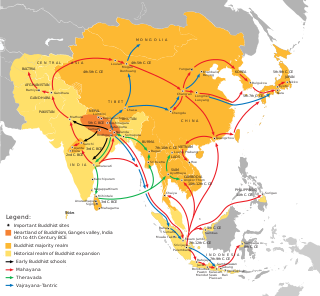
Buddhism entered Han China via the Silk Road, beginning in the 1st or 2nd century CE. The first documented translation efforts by Buddhist monks in China were in the 2nd century CE via the Kushan Empire into the Chinese territory bordering the Tarim Basin under Kanishka. These contacts transmitted strands of Sarvastivadan and Tamrashatiya Buddhism throughout the Eastern world.

The Western Regions or Xiyu was a historical name specified in Ancient Chinese chronicles between the 3rd century BC to the 8th century AD that referred to the regions west of the Yumen Pass, most often the Tarim Basin in present-day southern Xinjiang and Central Asia, though it was sometimes used more generally to refer to other regions to the west of China as well, such as Parthia and Tianzhu.
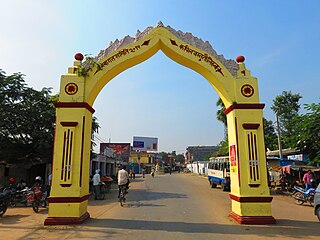
Kapilvastu is a municipality and administrative center of Kapilvastu District in Lumbini Province of southern Nepal. The municipality is located roughly 25 kilometres (16 mi) to the south-west of Lumbini, a UNESCO World Heritage Site and the birthplace of Gautama Buddha.

Shravasti ; Pali: 𑀲𑀸𑀯𑀢𑁆𑀣𑀻, romanized: Sāvatthī) is a town in Shravasti district in Indian State of Uttar Pradesh. It was the capital of the ancient Indian kingdom of Kosala and the place where the Buddha lived most after his enlightenment. It is near the Rapti river in the northeastern part of Uttar Pradesh India, close to the Nepalese border.
Samuel Beal was an Oriental scholar, and the first Englishman to translate directly from the Chinese the early records of Buddhism, thus illuminating Indian history.
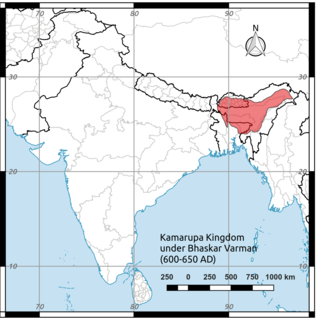
Bhaskaravarman (600–650) was king of medieval Kamarupa and the last of the Varman dynasty. After being captured by the Gauda king during the reign of his father, he was able to re-establish the rule of the Varmans. He made political alliances with Harshavardhana of Thaneswar, against the alliance of the Gauda and East Malwa. He was visited by Xuanzang and Wang Xuance, the envoys of the Tang dynasty who have left accounts of the king and the kingdom.
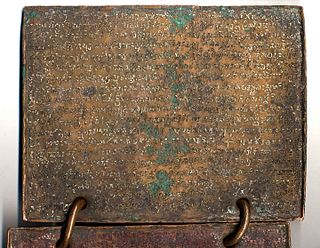
Shiladitya is the title of a 7th-century Indian king mentioned in the writings of the Chinese traveler Xuanzang.

Tilaurakot is a neighborhood in Kapilvastu Municipality in Kapilvastu District, in the Lumbini Province of southern Nepal. Previously it was a Village development committee. At the time of the 1991 Nepal census it had a population of 5684 people living in 944 individual households. It is situated 25 kilometers (15.5 mi) northwest of the Maya Devi Temple in Lumbini, and 4.5 kilometers (2.8 mi) southeast of Nigali Sagar in Nigalihawa.
Song Yun was a Chinese Buddhist monk who was sent by the pious Buddhist Empress Hu of the Northern Wei Dynasty with other monastic companions including Hui Zheng, Fa Li and Zheng Fouze, to northwestern India to search for Buddhist texts. They left the Wei capital Luoyang, on foot in 518 and returned in the winter of 522 with 170 Buddhist scriptures.
The Kingdom of Kapisa was a state located in what is now Afghanistan during the late 1st millennium CE. Its capital was the city of Kapisa. The kingdom stretched from the Hindu Kush in the north to Bamiyan and Kandahar in the south and west, out as far as the modern Jalalabad District in the east.

Yijing, formerly romanized as I-ching or I-tsing, born Zhang Wenming, was a Tang-era Chinese Buddhist monk famed as a traveller and translator. His account of his travels is an important source for the history of the medieval kingdoms along the sea route between China and India, especially Srivijaya in Indonesia. He also gave accounts of the Gupta Period. A student of the Buddhist university at Nālandā, he was also responsible for the translation of many Buddhist texts from Sanskrit and Pali into Chinese.
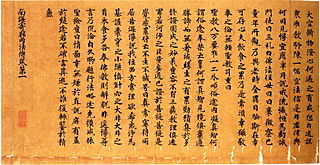
A Record of Buddhist Practices Sent Home from the Southern Sea, also known as the Nanhai Jigui Neifa Zhuan and by other translations, is a Buddhist travelogue by the Tang Chinese monk Yijing detailing his twenty five-year stay in India and Srivijaya between the years 671 and 695 CE.

Kapilavastu was an ancient city in the north of the South Asia which was the capital of the clan gaṇasaṅgha or "republic" of the Shakyas in the late Iron Age, around the 6th and 5th centuries BC. King Śuddhodana and Queen Māyā are believed to have lived at Kapilavastu, as did their son Prince Siddartha Gautama until he left the palace at the age of 29.

Gandhāran Buddhism refers to the Buddhist culture of ancient Gandhāra which was a major center of Buddhism in northwestern Pakistan from the 3rd century BCE to approximately 1200 CE. Ancient Gandhāra corresponds to modern day north Pakistan, mainly the Peshawar valley and Potohar plateau as well as Afghanistan's Jalalabad. The region has yielded the Gandhāran Buddhist texts written in Gāndhārī Prakrit the oldest Buddhist manuscripts yet discovered. Gandhāra was also home to a unique Buddhist artistic and architectural culture which blended elements from Indian, Hellenistic, Roman and Parthian art. Buddhist Gandhāra was also influential as the gateway through which Buddhism spread to Central Asia and China.
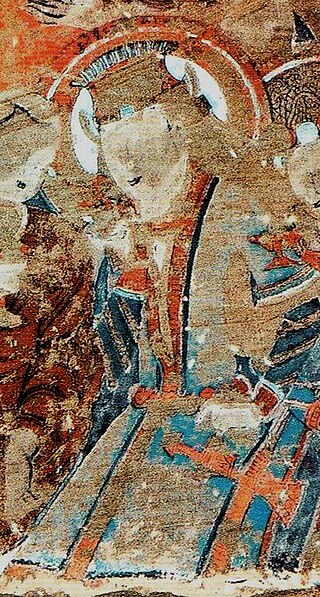
Suvarṇapuṣpa was a King of the Tarim Basin city-state of Kucha from 600 to 625. He was known in Buddhist Hybrid Sanskrit (BHS) as kucīśvara Suvarṇapuṣpa "Suvarṇapuṣpa, lord of Kucha". He was known in Chinese as Bái Sūfábójué as he sent an embassy to the court of the Tang dynasty in 618 CE acknowledging vassalship.
















